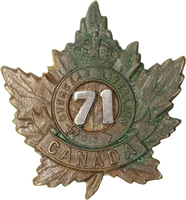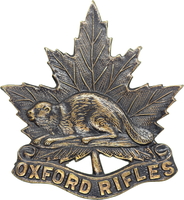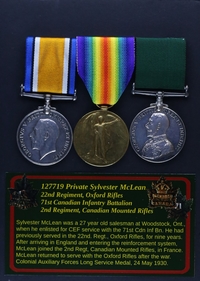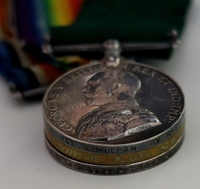
127719 Sergeant Sylvester McLean
22nd Regiment, The Oxford Rifles
71st Canadian Overseas Battalion
2nd Regiment, Canadian Mounted Rifles
By: Capt (ret'd) Michael M. O'Leary, CD, The RCR
Sylvester McLean was born in Woodstock, Ontario, on 10 Jul 1888. McLean's family, led by parents Donald and Emma (nee Zimmerman), can be found in the 1901 and 1911 Canadian Censuses. The two appearances of the family, although there are inevitable differences in the recording and transcription of names, shows that Sylvester is the third of four children, and the only son. In the 1901 census, Sylvester (12) is shown with three sisters, Laura (17), Mary (15), and Margaret (9). Grandmother, Mary McLean, also shares the household with the family. By the 1911 census, Donald and Emma, now 61 and 60 respectively, only have Sylvester (23) and Margaret ("Maggie," 19) still at home.
An older brother, Matthew, appears on the 1891 census but has already moved out of the family home by 1901. Matthew would also serve in the C.E.F., returning from Michigan to enlist with the 168th Battalion at Woodstock in May, 1916. He would serve overseas with the 1st Canadian Infantry Battalion and be wounded on 4 Oct 1918.
Sylvester McLean attested for service in the Canadian Expeditionary Force (C.E.F.) with the 71st Overseas Battalion at Woodstock, Ont., on 18 Mar 1916. A 27-year-old salesman, McLean was described on his attestation paper as 5 feet 10 inches tall, weighing 145 pounds, with a 35-inch chest, a fair complexion, hazel eyes, and fair hair. His religious denomination was Presbyterian. McLean identified his mother, Mrs. Daniel McLean, 346 Simcoe St., Woodstock, Ont., as his next of kin. On attesting with the 71st Battalion, McLean was given the regimental number 127719.
By the time he decided to attest for overseas service, McLean had been serving in the 22nd Regiment, Oxford Rifles, for nine years. The London Advertiser edition published on 24 Mar 1916 noted the arrival of new instruments for the band of the 71st Battalion, and also mentioned McLean enlistment:
"New Instruments Reach 71st Band.
[Special to the Advertiser.]
"Woodstock, March 23.--The new instruments for the band of the 71st Battalion arrived today. They are the finest collection of instruments ever brought into Woodstock. They were manufactured by Besson & Co., London, Eng., and cost about $1,800. Up to the present the band has been using the instruments of the old 22nd Oxford Rifles band. The instruments will be used for the first time at a concert to be given Sunday afternoon. Twenty-eight instruments were received and twenty-seven musicians are on the pay roll.
"Another member of the old 22nd Battalion band joined today. Sylvester McLean, a well-known young man of this city, and a fine clarinet player."
A week after attesting for CEF service, on 25 Mar 1916, Sylvester McLean (27) married Edith Letitia Millikin (23). The couple were married at Woodstock, Ont. They would have three children in the years after the war; Mary, Kenneth, and Margaret.
McLean initiated a monthly Pay Assignment of $20 out of his pay to Edith McLean, 346 Simcoe St., Woodstock, Ont., starting 1 Apr 1916. At a Private's rate of pay of $1.00 per day and ten cents field allowance, he was sending home about one-third of his pay each month. Mrs. McLean would also receive Separation Allowance each month while McLean served overseas. Starting at $20 per month, the Separation Allowance increased to $25 on 1 Dec 1917 and to $30 on 1 Sep 1918.
The 71st Battalion sailed from Halifax on 1 Apr 1916 aboard the troopship S.S. Olympic. The battalion arrived in England on 11 Apr 1916.
While there is no surviving evidence in his records to explain how he came before them, McLean was examined by a Standing Medical Board at Bramshott on 19 Jul 1916. The Board determined that he had "no disability" and noted that he "has had no training." He was recommended for eight weeks physical training. On 3 Aug 1916, McLean was struck off the strength of the 71st Battalion to the Canadian Casaulty Assembly Centre (C.C.A.C.) at Folkestone. On 7 Aug 1916, he was sent "On Command," i.e., a temporary duty assignment without changing parent units, to the 1st Canadian Command Centre (C.C.D.), Monks Horton, to complete eight weeks of physical training (P.T.) in order to get him fit for service at the front.
On 15 Sep 1916, McLean ceased to be attached to the 1st C.C.D. and was posted to the the 9th Battalion at St. Martin's Plain, Shorncliffe. After nearly three months here, he was sent "On Command" to the Division Massed Band (Overseas) on 7 Dec 1916, but this attachment only lasted until 13 Dec 1916. While it is not clear if he actually went anywhere before the attachment was canceled, this event in his service record is the first confirmation that he continued to be employed as a musician.
McLean was struck off the strength of the 9th Battalion and posted to the 9th Reserve Battalion on 25 Jan 1917. The 9th Res. Bn. was formed mostly from the men of the 9th Bn. plus some other troops at Shorncliffe. As the structure of reserve units in the CEF was evolving. On 14 Mar 1917, McLean was struck off the strength of the 9th Res. Bn. and posted to the 16th Res. Bn. at Seaford.
On 19 Mar 1917, McLean was finally on his way overseas to a front line unit. He was struck off the strength of the 9th Res. Bn. and proceeded overseas to France for the 2nd Canadian Mounted Rifles (2nd C.M.R.). The 2nd C.M.R. had sailed from Canada on 12 Jun 1915 and landed in France on 22 Sept 1915 as part of the 1st Canadian Mounted Rifles Brigade. Converted to infantry on 1 Jan 1916 it was amalgamated with 'B Squadron' and the headquarters staff of the 3rd Regiment, C.M.R., and re-designated the 2nd Canadian Mounted Rifles Battalion. In its new role, 2nd C.M.R. was a battalion of the 8th Canadian Infantry Brigade, 3rd Canadian Division.
McLean landed in France on 20 Mar 1917 and was taken on strength of the Canadian Base Depot (C.B.D.) awaiting while he waited to be sent forward to join his unit. After a month in France, he was sent forward and on 23 Apr 1917, he arrived at the unit in the field. As a reinforcement in late April, 1917, McLean would be filling a gap in the ranks of the unit left by the fighting at and after Vimy Ridge.
The Battle Honours awarded to the 2nd C.M.R. provide a glimpse of the actions the units was engaged in during the spring and summer of 1917 while McLean was with the unit:
- The Arras Offensive (9 Apr – 15 May, 1917)
- Hill 70 (15-25 Aug 1917)
- The Flanders Offensive (7 Jun – 10 Nov, 1917)
- Ypres, 1917 (31 Jul – 10 Nov. 1917)
The 2nd C.M.R's regimental history describes the importance of the band in a fighting battalion of C.E.F. and the efforts the unit took to form and maintain a high-quality band:
"One event this year [1917] of some importance to us was the formation of the band. Anyone who has seen tired, trench-worn and battle-weary men met and played to camp by their band will realize the importance, almost necessity, of such an institution to a fighting battalion; as the music starts, men, who before were so tired that they could scarcely put one foot in front of the other, straighten up instinctively and march along, even cracking jokes with one another. In November [1916], at a meeting of our officers, it was decided that it was up to us to purchase instruments and furnish necessary funds. As a result of this, while on leave I purchased the band instruments of the 62nd battalion from Lieut.-Colonel Hulme of Vancouver, while in the ranks we found some sixteen bandsmen, who made the nucleus of the band. Bombing Sergeant "Curley" Howells undertook to run the band practises until a bandmaster could be found; this he did, making up in enthusiasm what he lacked in knowledge, some of the bandsmen being unkind enough to say that he frequently conducted with his score upside down. Be that as it may, its numbers grew and it made such effective progress under Bandmaster S.C. Peatherstone, who came to us from the 48th Battalion, and Band Sergeant Hayward that in a year's time it was reckoned one of the best bands in the division."
As a musician and a member of the unit's band, McLean's task on the battlefield would often have been to act as a stretcher-bearer. This role would have taken him in and out of the trenches, and into No Man's Land following assaulting troops in battle. Exposed to all the same dangers as other soldiers in the trenches, his daily routine could often include carrying stretchers heavy with a wounded comrade along winding cramped trenches or across open shell-swept fields.
It is not until July 1917 that specific mention of the 2nd C.M.R's band is mentioned in the unit's War Diary. At 12 noon on 1 Jul 1917, the War Diary reports:
"The unveiling of the cross which has been erected at LA FOLIE FARM in memory of those of the 3rd Canadian Division who fell during the attack on VIMY RIDGE, April 9th, 1917, took place at 12 o'clock Noon, Sunday July 1st, 1917. (Map location S.29.a.2.3)
"The Battalion Brass Band furnished the music for the ceremony."
The 2nd C.M.R. followed the cycle of rotations in forward trenches, support trenches, and reserve positions that would characterize the infantry experience of the Great War. Each rotation into the forward line of trenches was about four days in duration between relief operations, and in each tour the unit suffered casualties killed and wounded. Like many soldiers of the war, McLean's experience was one of the steady cycling between trenches and reserve, without major incidents that necessitated entries in his service record.
On 6 Sep 1917, McLean was sent to the 3rd Division Training School. His purpose here was not detailed, but he would only be with the School for ten days. He reported sick on 16 Sep 1917 and was admitted to No. 58 Casualty Clearing Station. McLean's initial diagnosis was "P.U.O.," pyrexia (fever) of unknown origin, a commonly used label for trench fever.
Three days after going sick, on 19 Sep 1917, McLean was transferred by No. 5 Ambulance Train and admitted to No. 18 General Hospital at Camiers with a diagnosis of influenza. On 4 Oct 1917, he was discharged to Base Details. As McLean was being transferred rearward in the medical evacuation system, he was posted to the 3rd Canadian Infantry Base Depot (C.I.B.D.) at Etaples on 5 Oct 1917.
McLean departed the C.I.B.D. on 15 Oct 1917 for the Canadian Corps Reinforcement Depot (C.C.R.C.) and was taken on the strength of the Depot the following day. After a few weeks at the C.C.R.C., McLean would return to the 2nd C.M.R. and rejoin the unit in the field on 7 Nov 1917.
1918 started off well for McLean, with 14 days leave in the United Kingdom between the 8th and 23rd of January. On 19 Mar 1918, he was awarded a Good Conduct Badge. McLean's service record details no specific events for much of 1918, though his roles as musician and stretcher-bearer would have kept him busy in and out of the trenches.
The 2nd C.M.R. would be involved in the major campaigns of 1918 as shown by the unit's Battle Honours for the year:
- The Advance in Picardy (8 Aug – 3 Sep, 1918)
- Amiens (8-11 Aug 1918)
- The Breaking of the Hindenburg Line (26 Aug – 12 Oct, 1918)
- Arras, 1918 (26 Aug – 3 Sep 1918)
- Scarpe, 1918 (26-30 Aug 1918)
- Hindenburg Line, Battles of (12 Sep – 9 Oct 1918)
- Canal du Nord (27 Sep – 2 Oct 1918)
- Cambrai, 1918 (8-9 Oct 1918)
- Picardy (17 Oct – 11 Nov)
- Pursuit to Mons (11 Nov 1918)
The 2nd C.M.R's regimental history notes the role of the band on 9 Aug 1918 at Amiens;
"… we marched off, with our band playing "Marseillaise," moving forward in support three and four miles at a time, frequently under fire from the German heavies, but, as they were firing blindly and without observation, we had no difficulty in avoiding the shelled areas."
In the war's final moments, the band led the Battalion on its last marches before the Armistice:
"On the 10th [of November, 1918] we marched to Boussu and found the populace greatly excited; crowds met us as, headed by our band playing "Marseillaise," we entered the town, and girls gave us flowers and favours made of Belgian colours. We had very good billets here; the people seemingly could not do enough for us, and we heard the usual stories of Bosche brutality and tyranny."
At the end of the year, on 29 Dec 1918, McLean was granted 14 days Leave to the United Kingdom. He rejoined from leave on 14 Jan 1919 and a month after that, on 13 Feb 1919 he proceeded to England with the unit. On 15 Mar 1919, McLean was struck off the strength of 2nd C.M.R. and posted to "F" Wing, Casualty Clearing Centre, at Bramshott.
Sylvester McLean sailed for Canada aboard the S.S. Olympic at Southampton, Eng., on 17 Mar 1919. On leaving England's shores, he was struck off the strength of the Overseas Military Forces of Canada and taken on the strength of No. 1 District Depot at Toronto.
McLean was discharged from the C.E.F. at No. 1 District Depot on 29 Mar 1919. On discharge, he was issued a Class "A" War Service badge, numbered 84800. McLean was entitled to a War Service Gratuity of $420. This was paid to him in installments between March and August 1919.
For his service in the CEF, McLean was entitled to receive the British War Medal and the Victory Medal. These were despatched to him at 24 Vansittart Ave., Woodstock, Ont., on 26 Nov 1921.
McLean returned to the Oxford Rifles after the war, continuing his military service in the Canadian Militia. The Canada Gazette edition of 24 Mar 1930 announced the award of the Colonial Auxiliary Forces Long Service Medal to "Sgt. S. McLean, Oxford Rifles." This medal, instituted in 1899, was awarded for the completion of 20 years service in the ranks. It was replaced in 1930 by the Efficiency Medal.
Sylvester McLean died in 1960.
The online collection database of the Woodstock Museum contains some items that relate to Sylvester McLean and his military service. Among these are:
- A photo of the 2nd C.M.R. band with "Pte. McLean (holding clarinet)", although catalogued as the 71st Bn. band, the image description states that the base drum visibly reads 2nd C.M.R. (2002.6.1)
- A photograph of the band of the 22nd Regiment, circa 1930s, with Sylvester McLean identified (1988.33.4)
- A clarinet, circa 1910s, which came from the home of Sylvester McLean's son. (2009.12.1a-o)
- A flute with case, circa 1915 (2009.12.2a-b)
- A group photo of veterans of the 71st Battalion, dated 9 Oct 1942 (1985-30.1b)
- A First World War helmet attributed to McLean (2001.14.1)
- A group photo, circa 1920s, of the employees of the Warren (Kam) Organ Company of Woodstock, including Sylvester McLean (X1982.342.1)
- A photo of members of the Oxford Rifles band practicing, circa 1940s, including McLean (X1987.183.1)
Pro Patria
Visit a randomly selected page in The O'Leary Collection (or reload for another choice):
- The O'Leary Collection; Medals of The Royal Canadian Regiment.
- Researching Canadian Soldiers of the First World War
- Researching The Royal Canadian Regiment
- The RCR in the First World War
- Badges of The RCR
- The Senior Subaltern
- The Minute Book (blog)
- Rogue Papers
- Tactical Primers
- The Regimental Library
- Battle Honours
- Perpetuation of the CEF
- A Miscellany
- Quotes
- The Frontenac Times
- Site Map
QUICK LINKS
The O'Leary Collection—Medals of The Royal Canadian Regiment
Newest additions:
![]()
![]() SB-12725 Private Henry "Hank" Ard
SB-12725 Private Henry "Hank" Ard ![]()
WIA at Hill 187, Died of Wounds in Japan
![]()
![]() 2355331 Lance Corporal Albert Lorking
2355331 Lance Corporal Albert Lorking
Wounded in action, later a War Amps representative.
![]()
![]() 4334 / 477996 Pte Isaac Hamilton Wilcox
4334 / 477996 Pte Isaac Hamilton Wilcox
Permanent Force, South Africa, and C.E.F.
![]()
![]() 477019 Private Harold Ashcroft
477019 Private Harold Ashcroft
Transferred to the Tunnelers.
![]()
![]() 734231 Private Clark D. Thompson
734231 Private Clark D. Thompson ![]()
The older Thompson brother, killed in action.
![]()
![]() 733849 Private Norman Parker Thompson
733849 Private Norman Parker Thompson
The younger Thompson brother; post-war service in the Special Guard.
![]()
![]()
![]() A305 / 400305 Private Andrew Walker
A305 / 400305 Private Andrew Walker ![]()
"Previously reported Wounded, now Killed in Action."
![]()
![]() 823298 Pte Thomas Patrick Steele, M.M.
823298 Pte Thomas Patrick Steele, M.M. ![]()
… for gallant conduct in the field …
![]()
![]() P13066 Sergeant Harold Thompson
P13066 Sergeant Harold Thompson
Instrumental Soloist for over 20 years of Canadian Army service.
![]()
![]() 9609 / 477728 Private Albert Edward Piper
9609 / 477728 Private Albert Edward Piper
"Arrived from England as a STOWAWAY …"




